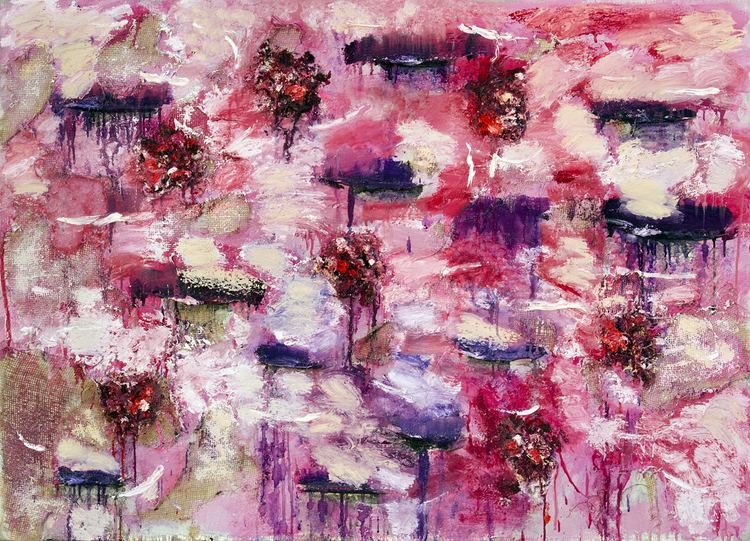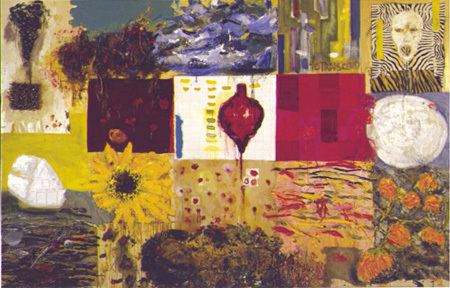Nationality American Period Modern art | Role Painter Name Joan Snyder Movies Art City #2: Simplicity | |
 | ||
Artwork Sweet Cathy's Song (For Cathy Elzea) Awards MacArthur Fellowship, Guggenheim Fellowship for Creative Arts, US & Canada | ||
Painter joan snyder 2007 macarthur fellow macarthur foundation
Joan Snyder, (born April 16, 1940), is an American painter from New York. She is a MacArthur Fellow, a Guggenheim Fellow, and a National Endowment for the Arts Fellow.
Contents
- Painter joan snyder 2007 macarthur fellow macarthur foundation
- Drc plenary joan snyder 2010 11 estelle lebowitz visiting artist in residence
- Honors and fellowships
- Personal life
- Education
- Works
- Stroke Paintings
- The Feminist Movement
- Exhibitions and Collections
- References

Snyder first gained public attention in the early 1970s with her gestural and elegant “stroke paintings,” which used the grid to deconstruct and retell the story of abstract painting. By the late seventies, Snyder had abandoned the formality of the grid. She began more explicitly incorporating symbols and text, as the paintings took on a more complex materiality. These early works were included in the 1973 and 1981 Whitney Biennials and the 1975 Corcoran Biennial.

"The functions of Ms. Snyder's art, first and foremost, are to further the tradition of painting and to explore the most serious aspects of the human condition; to connect us not only to one another and to nature but to ancient rites and myths. She reminds us that no matter how modern and civilized we are, art can still be raw, primitive and talismanic. Without apologies or decorum, Ms. Snyder's work awakens all of the things still wild within us." – Lance Esplund, WSJ

Often referred to as an autobiographical or confessional artist, Snyder’s paintings are narratives of both personal and communal experiences. Through a fiercely individual approach and persistent experimentation with technique and materials, Snyder has extended the expressive potential of abstract painting, inspiring generations of emerging artists.

Drc plenary joan snyder 2010 11 estelle lebowitz visiting artist in residence
Honors and fellowships
Snyder is the recipient of a 1974 National Endowment for the Arts Fellowship, a 1983 John Simon Guggenheim Memorial Fellowship, a 2007 MacArthur Fellowship, and a 2016 Arts & Letters Award in Art from the American Academy of Arts & Letters.
Personal life
Joan Snyder was born on April 16, 1940 in Highland Park, New Jersey. She received her AB from Douglass College in 1962 and her MFA from Rutgers University in 1966.
In 1969 Snyder married photographer Larry Fink. She gave birth to their daughter, Molly, in 1979. Her grandson Elijah was born in 2012. In 2011 Snyder married her partner of 28 year, Margaret Cammer, a retired New York State Acting Supreme Court Judge and the former NY Deputy Administrative Judge of The New York City Civil Court.
Snyder currently lives and works in Brooklyn and Woodstock, NY. She is represented by Franklin Parrasch Gallery in New York, NY, Parrasch Heijnen Gallery in Los Angeles, CA, and Elena Zang Gallery in Woodstock, NY.
Education
After graduating from Douglass College in 1962 with a BA in Sociology, Snyder received her MFA from Rutgers University in 1966.
Works
While living on a New Jersey farm in 1962, Snyder worked in a studio on the Raritan River in New Brunswick, creating some of her earliest paintings of farm and landscape scenes, as well as expressionist portraits. In the mid to late 60’s she was working explicitly with the idea of female sensibility, using materials in her paintings such as lentil seeds, flocking, thread, glitter and gauze. Snyder describes her processes involving non-art materials as a type of ritual act for the painting. Snyder’s ideas often take form in her paintings through other means other than paint such as music, poetry and words to further push the intent of her pieces. These works eventually led to Snyder’s seminal stroke paintings in the late 60’s and early ‘70’s.Critics have classified her work as inaccessible to viewers because of her messy, crowded style of painting. Snyder working alongside artists such as Mary Heilmann, Jennifer Bartlett and Harriet Korman during the 1960s, all of whom were attempting to bring more process into their art making.
Some of Snyders work includes:
Stroke Paintings
In the early 1970’s Snyder began to explore paint as subject, reconstructing abstract painting through gestural strokes on canvas over a gridded background. These paintings, more commonly known as her ‘stroke’ paintings, were included in the 1973 and 1981 Whitney Biennials as well as the Corcoran Biennial in 1975.
Following the stroke paintings in the mid 70s, Snyder’s work once again revisited female sensibility and the work more vigorously explored materiality. By the late 70s she abandoned the formality of the grid and began to more explicitly incorporate symbols and text in her paintings.
The Feminist Movement
Snyder is a self proclaimed feminist and creates work in the vain of abstract expressionism because of how that genre of painting is over dominated by male artists. Within the work she uses shapes and marks that evoke female anatomy such as vaginal openings, nipples and breasts.
In 1971 Snyder founded the Mary H. Dana Women Artist Series, “the oldest continuous running exhibition space in the United States dedicated to making visible the work of emerging and established contemporary women artists.”
She became a contributing member of Heresies, a Feminist Publication On Art and Politics, alongside artists and critics including Ida Applebroog, Joyce Kozloff, Lucy Lippard, Nina Yankowitz, Joan Braderman, Sue Heinemann and Miriam Schapiro, among many others.
Exhibitions and Collections
In 1994, Joan Snyder, Painter: 1969 to Now was displayed at Parrish Art Museum in Southampton, L.I. It was an exhibition made up of the first 25 years of her life’s work up until that point in her career.
In 2005, The Jewish Museum in New York City presented a 35-year survey of Snyder’s work that traveled to the Danforth Museum of Art in Framingham, Massachusetts. The exhibition was accompanied by a monograph, Joan Snyder, with an introduction by Norman Kleeblatt and essays by Hayden Herrera and Jenni Sorkin.
In 2011, Dancing With The Dark: Joan Snyder Prints 1963-2010 opened at the Zimmerli Art Museum at Rutgers University, New Brunswick, NJ, and traveled to Boston University Art Gallery, Boston, MA; University of Richmond Museums, Richmond, VA; University of New Mexico Art Museum, Albuquerque, NM accompanied by a comprehensive exhibition catalogue with an essay by the curator, Marilyn Symmes.
In 2015, Sub Rosa opened at Franklin Parrasch Gallery in Manhattan NY, which was an exhibition of the work she had been making the two years prior to the exhibition.
Snyder’s work can be found in many public collections including The Metropolitan Museum of Art, The Museum of Modern Art, The Whitney Museum of American Art, The Jewish Museum, The Guggenheim, The High Museum of Art, The San Francisco Museum of Modern Art, Art Institute of Chicago, The Phillips Collection, The Dallas Museum of Fine Art and The National Museum of Women in the Arts.
